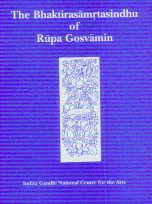Rupa Gosvamin and David L. Haberman (trans.)
Bhaktirasamrtasindhu of Rupa Gosvamin
Gosvamin, Rupa; David L. Haberman (trans.);
Bhaktirasamrtasindhu of Rupa Gosvamin
Motilal Banarsidass Publ. 2003 [~ 1541 AD, Sanskrit] [gbook]
ISBN 812081861X
topics: | religion | vaishnavism | hinduism | bhakti
From introduction by David Haberman
Emotions and religiosity
Many religious traditions are suspicious of emotions, unsure if they can be trusted at all in ultimate spiritual pursuits. e.g. Patanjali defines yoga as the suppression of mental or emotional activity.
Emotional agitation is considered to be an enemy threatening the ultimate religious goal, defined as utter tranquility.
This view is challenged in the Bhakti traditions (and in many other mystic traditions : Sufi, vAmAchAri Tantra, and in Christian mysticism as in Teresa of Avila, etc.). In Bhaktirasamrtasindhu, Rupa Gosvamin recognizes the value of emotions, they are the glue that potentially binds one in a direct loving relationship to God. This love of God - the core of all true emotions - is itself a manifestation of divinity.
Friedhelm Hardy [3] contends that the bhAgavata purANa is based on the emotional religion of the southern AlvArs - this was united with the northern Vedanta philosophy and spread through the authority of a Sanskrit purANa to infl the development of Krishna bhakti throughout India.
13th c. - shrIdhara's commentary on the bhAgavata : came to be related to the religious life of rasa as an emotional relationship. bhAgavata mAhAtmya (later preface, not fully reliable) : claims krishNa-bhakti as having originated in drAviDa, and matured in karNATaka, and then in mahArAshTra and gujarAt, finally reaching vrindAvana.
Rupa Gosvamin life
Rupa [rUpa] Gosvamin (born c.1470, died c. 1557), was a disciple of sri Chaitanya. Born in rAmakeli [qb], Bengal, to a Karnataka Brahmin family who had been forced to migrate owing to land conflicts. Middle of three sons - eldest sanAtana is ack-ed by Rupa as his guru - he had been trained in navya-nyAya by bAsudev sarvabhauma and madhusudan vidhAvAchaspati; youngest Anupama is father of jIva gosvAmin, who commentated on rUpa. sanAtana and rUpa joined Nawab Husain Shah's court where they were appointed sAkar mallik (revenue minister) and dabIr khAs (principal secretary). In 1515, Chaitanya visited Ramkeli on his way to Vrindavana. After this, Rupa and Anupama secretly went to meet Chaitanya at Allahabad. Chaitanya instructed Rupa to proceed to Vraja [RG would have liked to go with C to Kasi], where he was to work on restoring its sites etc. He later spent two months with Chaitanya at Puri (Nilachal). He established the Madanamohana temple at Vrindavana; Sanatana established Govindadeva. rUpa composed Bhaktirasamrtasindhu around 1541. Many elements from this and its sequel text were incorporated into the vaishnavist hagiography, particularly in KrishnadAsa kavirAj's influential Chaitanya CharitAmrita.
Bhakti Renaissance in 16th c. Vraja
The 16th c. was a period of great efflorescence of Hinduism in Vraja. It
started during Sikandar Lodi's stewardship at Delhi - though he is generally
portrayed as an anti-Hindu bigot. In 1525, Babur rode in through the Khyber
and conquered the Doab. After his death in 1530, Humayun was ousted by Sher
Shah (d. 1545), and the Afghani-Mughal conflict continued beyond Humayun's
return in 1555 and his death in 1556. In such times, Akbar forged
alliances with Hindu princes, and employed many high-ranking Hindu officials;
there was thus an environment conducive to Hindu cultural development.
A number of Hindu seers were converging on Vrindavana in search for the
rAsa-lIlA lands where Krishna sported with Radha. This included LokanAtha
whom Chaitanya had sent from NabadvIpa c.1509; Chaitanya himself in 1514,
and then rUpa and SanATan who became part of the ShaDa goswamI, or six
pundits of vaisnavism: Sanatan, Rupa, Raghunath Das (arr.1530), Gopal
Bhatta (from shrIrangam temple in S. TN), Raghunath Bhatta (from Varanasi)
and Jiva. They were all more or followers of Chaitanyadev, and contributed
widely to Gaudiya Vaisnavism. Also nArAyaNa bhaTTa from Madurai, and
VishvanAtha chakravartin (17th c).
Also non-Gaudiyas :
Vallabhacharya - Tailang brAhmaNa from Andhra, arrived in early 16th c. and
established the popular lineage (samprAdAya) of the puShTi mArga.
Hita HarivaMsha: estd rAdhAvallabha temple and wrote passionate poems still
used by the small but infl. rAdhAvallabhi samprAdAya
svAmi haridAsa: alleged teacher of tAnsen
mAdhavendra puri (not clear if from Bengal or the South) - estd the Krishna
shrine on Mt Govardhana.
Also, the followers of the 13th c. Marathi saint Nimbark, played a role at
Vraja.
The Bhaktirasamrtasindhu
Most of the text is an annotated compilation referrinng to other texts such as the bhAgavata, various other purANas, the giTa, the haribhaktivilAsa etc. One of the claims is that devotion is superior to logic when it comes to the ultimate pursuit. Haberman provides the Sanskrit text along with his annotations. The three paths of Sadhana bhakti include "Vaidhi Bhakti" (its 64 tenets include surrender to Guru, renounce ordinary pleasures for Krishnna, etc.). BhAva bhakti, and Prema Bhakti. The Devotee can meditate on the 64 attributes of Krishna as a lover - good-looking, strong, youthful, knowing many languages, eloquent, intelligent, learned, witty, artistic, and so on; each trait illustrated with suitable instances from the epics and purANas. Love may be expressed by dancing, singing, shrieking, sighing, whirling, laughing, and even hiccuping.
amitabha mukerjee (mukerjee [at-symbol] gmail) 2013 Mar 20
